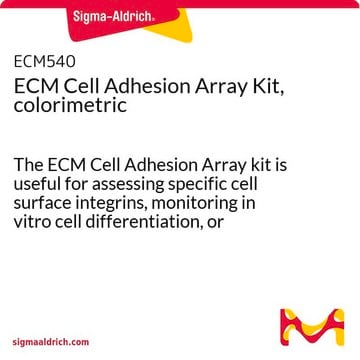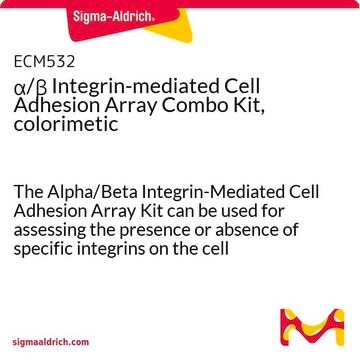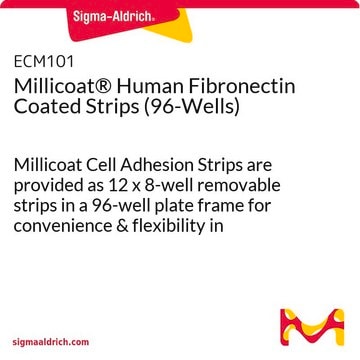推薦產品
物種活性
human
品質等級
製造商/商標名
Chemicon®
Millicoat®
包裝
pkg of 96-well plate(s) (for fibronectin, vitronectin, laminin, collagen I & collagen IV)
技術
activity assay: suitable
cell based assay: suitable
輸入
sample type neural stem cell(s)
sample type: human embryonic stem cell(s)
sample type: mouse embryonic stem cell(s)
sample type epithelial cells
sample type hematopoietic stem cell(s)
sample type pancreatic stem cell(s)
sample type induced pluripotent stem cell(s)
sample type mesenchymal stem cell(s)
檢測方法
colorimetric
運輸包裝
wet ice
一般說明
應用
NOTE: Optimal assay performance is obtained using subconfluent cell cultures. This can be achieved by splitting the cells 1 to 2 days prior to performing the assay.
1. Rehydrate the strips with 200 mL of PBS per well for at least 15 minutes at room temperature. Remove the PBS from the rehydated strips.
2. Prepare a single cell suspension, preferably using a non-enzymatic dissociation buffer. Optimum cell density may be determined by titration of the cells. A common starting range is between 1x10E05 to 1x10E07 cells/mL.
3. Add 100 mL of the diluted cell suspension to each well. Incubate the plate at 37°C for 1 hour in a CO2 incubator. Gently wash the plate 3 times with PBS containing Ca2+/Mg2+ (200 mL/well).
4. Add 100 mL/well of 0.2% crystal violet in 10% ethanol to each well. Incubate for 5 minutes at room temperature. Remove the stain from the wells. Gently wash the plate 3 times with PBS (300 mL/well).
5. Add 100 mL of Solubilization Buffer (A 50/50 mixture of 0.1M NaH2PO, pH 4.5 and 50% ethanol) to each well. Allow strips to incubate and gently shake at room temperature until the cell-bound stain is completely solubilized; approximately 5 minutes.
6. Determine the absorbances at 540 - 570 nm on a microplate reader.
Cell Structure
儲存和穩定性
法律資訊
免責聲明
儲存類別代碼
11 - Combustible Solids
分析證明 (COA)
輸入產品批次/批號來搜索 分析證明 (COA)。在產品’s標籤上找到批次和批號,寫有 ‘Lot’或‘Batch’.。
條款
This page covers the ECM coating protocols developed for four types of ECMs on Millicell®-CM inserts, Collagen Type 1, Fibronectin, Laminin, and Matrigel.
本頁涵蓋針對 Millicell®-CM 插片上四種類型 ECM(1 型膠原蛋白、纖維連結蛋白、層粘結蛋白和 Matrigel)所開發的 ECM 塗佈方案。
我們的科學家團隊在所有研究領域都有豐富的經驗,包括生命科學、材料科學、化學合成、色譜、分析等.
聯絡技術服務






